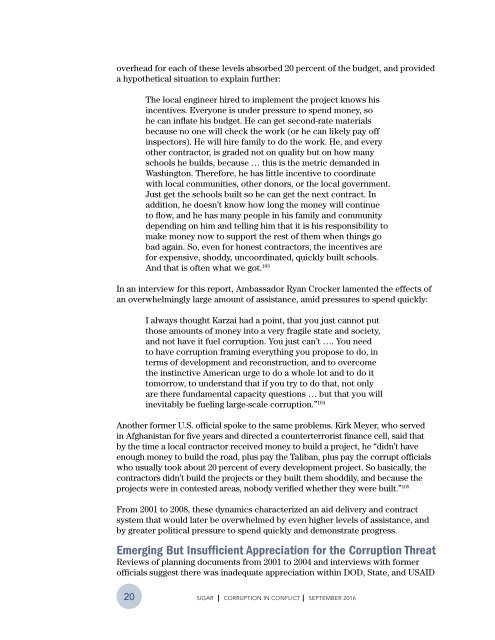CORRUPTION IN CONFLICT
5IlaWjQej
5IlaWjQej
You also want an ePaper? Increase the reach of your titles
YUMPU automatically turns print PDFs into web optimized ePapers that Google loves.
overhead for each of these levels absorbed 20 percent of the budget, and provided<br />
a hypothetical situation to explain further:<br />
The local engineer hired to implement the project knows his<br />
incentives. Everyone is under pressure to spend money, so<br />
he can inflate his budget. He can get second-rate materials<br />
because no one will check the work (or he can likely pay off<br />
inspectors). He will hire family to do the work. He, and every<br />
other contractor, is graded not on quality but on how many<br />
schools he builds, because … this is the metric demanded in<br />
Washington. Therefore, he has little incentive to coordinate<br />
with local communities, other donors, or the local government.<br />
Just get the schools built so he can get the next contract. In<br />
addition, he doesn’t know how long the money will continue<br />
to flow, and he has many people in his family and community<br />
depending on him and telling him that it is his responsibility to<br />
make money now to support the rest of them when things go<br />
bad again. So, even for honest contractors, the incentives are<br />
for expensive, shoddy, uncoordinated, quickly built schools.<br />
And that is often what we got. 103<br />
In an interview for this report, Ambassador Ryan Crocker lamented the effects of<br />
an overwhelmingly large amount of assistance, amid pressures to spend quickly:<br />
I always thought Karzai had a point, that you just cannot put<br />
those amounts of money into a very fragile state and society,<br />
and not have it fuel corruption. You just can’t …. You need<br />
to have corruption framing everything you propose to do, in<br />
terms of development and reconstruction, and to overcome<br />
the instinctive American urge to do a whole lot and to do it<br />
tomorrow, to understand that if you try to do that, not only<br />
are there fundamental capacity questions … but that you will<br />
inevitably be fueling large-scale corruption.” 104<br />
Another former U.S. official spoke to the same problems. Kirk Meyer, who served<br />
in Afghanistan for five years and directed a counterterrorist finance cell, said that<br />
by the time a local contractor received money to build a project, he “didn’t have<br />
enough money to build the road, plus pay the Taliban, plus pay the corrupt officials<br />
who usually took about 20 percent of every development project. So basically, the<br />
contractors didn’t build the projects or they built them shoddily, and because the<br />
projects were in contested areas, nobody verified whether they were built.” 105<br />
From 2001 to 2008, these dynamics characterized an aid delivery and contract<br />
system that would later be overwhelmed by even higher levels of assistance, and<br />
by greater political pressure to spend quickly and demonstrate progress.<br />
Emerging But Insufficient Appreciation for the Corruption Threat<br />
Reviews of planning documents from 2001 to 2004 and interviews with former<br />
officials suggest there was inadequate appreciation within DOD, State, and USAID<br />
20<br />
SIGAR I <strong>CORRUPTION</strong> <strong>IN</strong> <strong>CONFLICT</strong> I SEPTEMBER 2016


